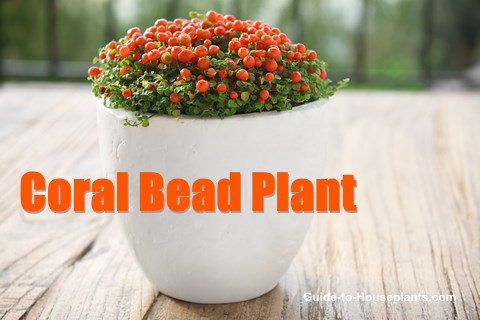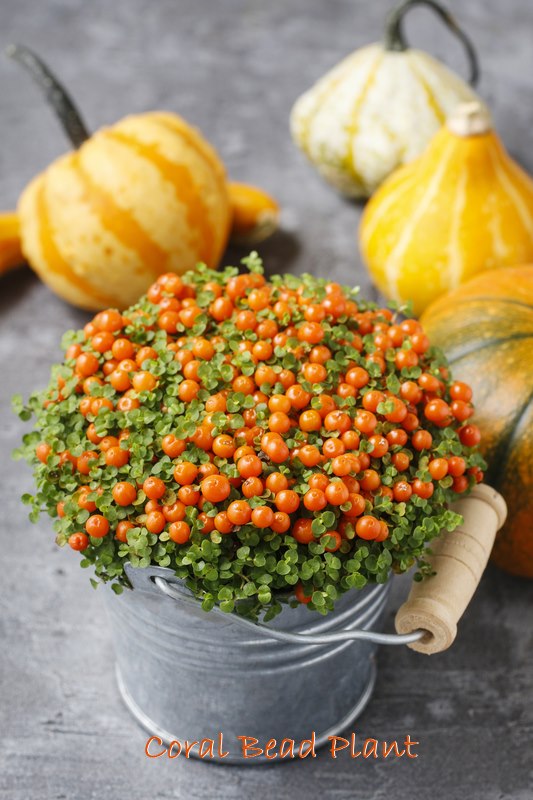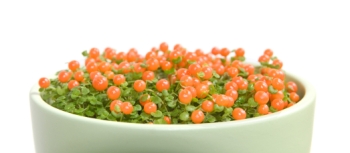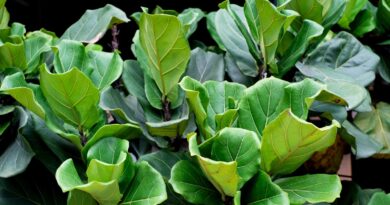Nertera granadensis – Coral Bead Plant Care and Pictures
Botanical Name: Nertera granadensis
This unusual ornamental gets its common name Coral Bead Plant for the gorgeous show of color it puts on in summer and fall.
Growing in a thick mat of tiny, dark-green leaves on intertwining stems, its foliage is attractive on its own. However, small, white flowers appear in summer only to be upstaged by bright, orange-red berries. You can expect the fiery berries to completely cover the foliage and last for months.

Nertera granadensis has become a novelty item in recent years. You may find small plants for sale in fall already covered with coral color berries. It likes the cool fall weather, so this may be an ideal time to pick one up. It’s a perennial so you’ll enjoy it for years to come.
 Photo Credit ©Agneskantaruk
Photo Credit ©AgneskantarukBecause of its need for cool temperatures and high humidity, Nertera granadensis can be difficult to please indoors.
Moving the container outdoors in spring will give it the cool air and bright light it needs to flower and produce berries. Just put the plant in a sheltered spot out of cold winds and direct sun. If it’s kept too warm, Nertera granadensis will be a foliage plant without berries. It will still be attractive. In fact, the foliage looks a lot like Baby’s Tears (Soleirolia soleirolii).
Repot in spring only when it gets crowded, probably every couple years. Its creeping stems need contact with soil to keep growing. This is a good time to divide the plant, if you want. Nertera granadensis has shallow roots and is easy to divide for more plants. Because of its shallow roots, shallow pots will do.
Common names for Nertera granadensis are: Coral Bead Plant, Pincushion Plant and Coral Moss. This plant is in the Rubiaceae family along with such unlikely relatives as the coffee plant and gardenia.
Nertera Granadensis Care Tips

Origin: New Zealand, Eastern Australia, Southeast Asia and South America
Height: 3 in (8 cm); it spreads out rather than up
Light: Bright light; no direct sun. Hot direct sunlight will cause the berries to shrivel.
Water: Keep soil evenly moist at all times, but not soggy. Don’t allow Nertera granadensis to dry out. Shriveled leaves indicate the plant is thirsty. To prevent getting the leaves wet, try to water the soil and not the plant. Or water from the bottom — use a pot with drainage holes and set the pot in a saucer of water; it will drink up water as needed.
Humidity: Aim for 50% relative humidity or higher. Mist it daily from the time it flowers until the berries have formed. You can boost humidity by putting Nertera granadensis on a tray with pebbles in the bottom with a little water. The pebbles keep the pot above the water so the roots don’t rot. I do this for some of my plants and it works beautifully to add humidity to the air around them. A cool-mist room humidifier works well, too.
Temperature: Cool to average (55-70°F/13-21°C) temperatures. Keep plant away from cold blasts from doors and windows and away from heat/AC vents. If you move your plant outdoors for the summer and fall, bring it back when temps drop below 55°/13°C at night.
Soil: 2 parts peat moss-based potting mix with 1 part horticultural sand or perlite for good drainage
Fertilizer: Feed once a month in spring and summer, with a water-soluble fertilizer at half strength, while the berries are on the plant. If you’re watering from the bottom, add fertilizer to the water tray.
Propagation: Division; gently pull apart clumps and plant them in separate containers. Can also be grown from seed or from tip cuttings in spring.




